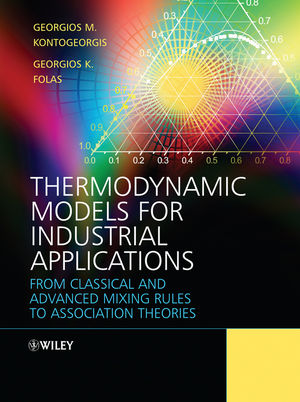Thermodynamic Models for Industrial Applications: From Classical and Advanced Mixing Rules to Association TheoriesISBN: 978-0-470-69726-9
Hardcover
728 pages
March 2010
 This is a Print-on-Demand title. It will be printed specifically to fill your order. Please allow an additional 10-15 days delivery time. The book is not returnable.
|
||||||
About the Authors.
Acknowledgments.
List of Abbreviations.
List of Symbols.
PART A INTRODUCTION.
1 Thermodynamics for Process and Product Design.
Appendix.
References.
2 Intermolecular Forces and Thermodynamic Models.
2.1 General.
2.2 Coulombic and van der Waals forces.
2.3 Quasi-chemical forces with emphasis on hydrogen bonding.
2.4 Some applications of intermolecular forces in model development.
2.5 Concluding remarks.
References.
PART B THE CLASSICAL MODELS.
3 Cubic equations of state: the classical mixing rules.
3.1 General.
3.2 On the parameter estimation.
3.3 Analysis of the advantages and shortcomings of cubic EoS.
3.4 Some recent developments with cubic EoS.
3.5 Concluding remarks.
Appendix.
References.
4 Activity coefficient models Part 1: random-mixing based models
4.1 Introduction to the random-mixing models.
4.2 Experimental activity coefficients.
4.3 The Margules equation.
4.4 From the van der Waals and van Laar equation to the regular solution theory.
4.5 Applications of the Regular Solution Theory.
4.6 SLE with emphasis on wax formation.
4.7 Asphaltene precipitation.
4.8 Concluding remarks about the random-mixing-based models.
Appendix.
References.
5 Activity coefficient models Part 2: local composition models, from Wilson and NRTL to UNIQUAC and UNIFAC.
5.1 General.
5.2 Overview of the local composition models.
5.3 The theoretical limitations.
5.4 Range of applicability of the LC models.
5.5 On the theoretical significance of the interaction parameters.
5.6 LC models: some unifying concepts.
5.7 The group contribution principle and UNIFAC.
5.8 Local-composition-free–volume models for polymers.
5.9 Conclusions: is UNIQUAC the best local composition model available today?
Appendix.
References.
6 The EoS/ GE mixing rules for cubic equations of state.
6.1 General.
6.2 The infinite pressure limit (the Huron-Vidal mixing rule).
6.3 The zero-reference pressure limit (The Michelsen approach).
6.4 Successes and limitations of zero reference pressure models.
6.5 The Wong–Sandler (WS) mixing rule.
6.6 EoS/ GE approaches suitable for asymmetric mixtures.
6.7 Applications of the LCVM, MHV2, PSRK and WS mixing rules.
6.8 Cubic EoS for polymers.
6.9 Conclusions: achievements and limitations of the EoS/ GE models.
6.10 Recommended models – so far.
Appendix.
References.
PART C ADVANCED MODELS AND THEIR APPLICATIONS.
7 Association theories and models: the role of spectroscopy.
7.1 Introduction.
7.2 Three different association theories.
7.3 The chemical and perturbation theories.
7.4 Spectroscopy and association theories.
7.5 Concluding remarks.
Appendix.
References.
8 The Statistical Associating Fluid Theory (SAFT).
8.1 The SAFT EoS: a brief look at the history and major developments.
8.2 The SAFT equations.
8.3 Parameterization of SAFT.
8.4 Applications of SAFT to non-polar molecules.
8.5 GC SAFT approaches.
8.6 Concluding remarks.
Appendix.
References.
9 The Cubic-Plus-Association equation of state.
9.1 Introduction.
9.2 The CPA EoS.
9.3 Parameter estimation: pure compounds.
9.4 The First applications.
9.5 Conclusions.
Appendix.
References.
10 Applications of CPA to the oil and gas industry.
10.1 General.
10.2 Glycol–water–hydrocarbon phase equilibria.
10.3 Gas hydrates.
10.4 Gas phase water content calculations.
10.5 Mixtures with acid gases (CO2 and H2S).
10.6 Reservoir fluids.
10.7 Conclusions.
References.
11 Applications of CPA to chemical industries.
11.1 Introduction.
11.2 Aqueous mixtures with heavy alcohols.
11.3 Amines and ketones.
11.4 Mixtures with organic acids.
11.5 Mixtures with ethers and esters.
11.6 Multifunctional chemicals: glycolethers and alkanolamines.
11.7 Complex aqueous mixtures.
11.8 Concluding remarks.
Appendix.
References.
12 Extension of CPA and SAFT to new systems: worked examples and guidelines.
12.1 Introduction.
12.2 The case of sulfolane: CPA application.
12.3 Application of sPC–SAFT to sulfolane-related systems.
12.4 Applicability of association theories and cubic EoS with advanced mixing rules (EoS/GEmodels) to polar chemicals.
12.5 Phenols.
12.6 Conclusions.
References.
13 Applications of SAFT to polar and associating mixtures.
13.1 Introduction.
13.2 Water-hydrocarbons.
13.3 Alcohols, amines and alkanolamines.
13.4 Glycols.
13.5 Organic Acids.
13.6 Polar non-associating compounds.
13.7 Flow assurance (asphaltenes and gas hydrate inhibitors).
13.8 Concluding Remarks.
References.
14 Applications of SAFT to polymers.
14.1 Overview.
14.2 Estimation of parameters for polymers for SAFT-type EoS.
14.3 Low-pressure phase equilibria (VLE and LLE) using simplified PC–SAFT.
14.4 High-pressure phase equilibria.
14.5 Co-polymers.
14.6 Concluding remarks.
Appendix.
References.
PART D THERMODYNAMICS AND OTHER DISCIPLINES.
15 Models for electrolyte systems.
15.1 Introduction: importance of electrolyte systems and modeling challenges.
15.2 Theories of ionic (long-range) interactions.
15.3 Electrolyte models: activity coefficients.
15.4 Electrolyte models: Equation of State.
15.5 Comparison of electrolyte EoS: capabilities and limitations.
15.6 Thermodynamic models for CO2–water–alkanolamines.
15.7 Concluding remarks.
References.
16 Quantum chemistry in engineering thermodynamics.
16.1 Introduction.
16.2 The COSMO—RS method.
16.3 Estimation of association model parameters using QC.
16.4 Estimation of size parameters of SFT-type models from QC.
16.5 Conclusions.
References.
17 Environmental thermodynamics.
17.1 Introduction.
17.2 Distribution of chemicals in environmental ecosystems.
17.3 Environmentally friendly solvents: supercritical fluids.
17.4 Conclusions.
References.
18 Thermodynamics and colloid and surface chemistry.
18.1 General.
18.2 Intermolecular vs. interparticle forces.
18.3 Interparticle forces in colloids and interfaces.
18.4 Acid–base concepts in adhesion studies.
18.5 Surface and interfacial tensions from thermodynamic models.
18.6 Hydrophilicity.
18.7 Micellization and surfactant solutions.
18.8 Adsorption.
18.9 Conclusions.
References.
19 Thermodynamics for biotechnology.
19.1 Introduction.
19.2 Models for Pharmaceuticals.
19.3 Models for amino acids and polypeptides.
19.4 Adsorption of proteins and chromatography.
19.5 Semi-productive models for protein systems.
19.6 Concluding Remarks.
Appendix.
References.
20 Epilogue: thermodynamic challenges in the twenty-first century.
20.1 In brief.
20.2 Petroleum and chemical industries.
20.3 Chemicals including polymers and complex product design.
20.4 Biotechnology including pharmaceuticals.
20.5 How future needs will be addressed.
References.
Index.



